

2010 Annual
Bull & Bear Report
Inland Empire Numismatics,
Inc. Winners and Losers of 2010
The principles at Inland Empire are proud to offer this study on what we feel are the best opportunities in U.S. Numismatics to own for the year of 2010 and for the emerging and strengthening Bull Market for U.S. Rare Coins. The coins we highlight here are well researched; thoughtfully chosen examples of what we feel are the best in Numismatics. No "Flash in the Pan" coins, no promotional items, no fluff. These coins are the bedrock of the coin market and cannot be controlled by us or any one company. We cannot guarantee that we will even be able to find many of the coins listed below; they are that rare and desirable. We hope that you will be encouraged and energized by the choices laid out for you.
1. The Top Ten Picks for 2010
(based on the popular book by Garrett/Guth, 100 Greatest U.S. Coins)
2. Copper, Silver and Gold Coins Dated 1793-1834
3. PROOF GOLD dated 1856-1899, 1908-1915
4. Better date $20 Saint-Gaudens Double Eagles, $10 Indians,
$5 Indians
5. SEATED LIBERTY SILVER DOLLARS, 1840 - 1873
(Mint State & Proof)
6. CONTINENTAL DOLLARS, 1776
(all varieties/ Pewter and Brass)
7. Cameo and Ultra Cameo (Silver) Seated Liberty and
Barber Coinage in Proof
8. PROOF SETS struck between 1834 and 1915
9. U.S. SILVER COMMEMORATIVES
10. COLONIAL COINS
SOME HONORABLE MENTIONS
TERRITORIAL GOLD COINAGE
COLLECTIONS OF EARLY COINS
And Now for the Top Ten Coins To Avoid
1. Kellogg $50 and Baldwin $10 "Horseman" gold Restrike coins
2. Treasure Bars
3. Certified Gold or Silver American Eagles Bullion coins,
PR or MS
4. Modern Contemporary Commemoratives 1982 to present
5. Certified State Quarters
6. Error coinage
7. High Grade Registry Sets of Modern Singles pre-1950
8. Walking Liberty half dollars 1941-1947:
the 20 coin "Short Set."
9. Copper coinage
10. $2.50 Indians
Editors Note: That's the good news and the bad. Some of the categories are broad but that is done on purpose. The coin market is a fluid industry and we want to be able to impart the most timely and valuable information we can. To do this, the information needs to be fresh and immediate. We encourage you to call your portfolio manager today and find out about the coins available-right now, not warmed over stale inventory.
Thank you and we hope you find our information and musings helpful.
David W. Hunt
The principles at Inland Empire are proud to offer this study on what we feel are the best opportunities in U.S. Numismatics to own for the year of 2010 and for the emerging and strengthening Bull Market for U.S. Rare Coins. The coins we highlight here are well researched; thoughtfully chosen examples of what we feel are the best in Numismatics. No "Flash in the Pan" coins, no promotional items, no fluff. These coins are the bedrock of the coin market and cannot be controlled by us or any one company. We cannot guarantee that we will even be able to find many of the coins listed below; they are that rare and desirable. We hope that you will be encouraged and energized by the choices laid out for you.
1. The Top Ten Picks for 2010
(based on the popular book by Garrett/Guth, 100 Greatest U.S. Coins)
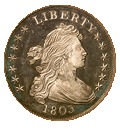 |
This fabulous book highlights the voting compilation of many of the top numismatists in the country as to what they feel are the most sought after coins in the entire Coin World. The criteria behind these choices are predicated on the following factors:
• Rarity: The first word in Rare Coins is… • Value: Not all expensive coins are worth the money and the same holds true for inexpensive coins. This list, though |
|
weighted to the pricey, has hidden bargains.
• Quality. Because of extreme scarcity there are compromises to be made. Try for as close to Condition Census as possible. • Popularity: When choosing a coin to buy, keep the thought in mind that you will need to sell it some day. A coin with a good story makes for an easy sale. • Beauty: Great coins are aesthetically pleasing. • History: Much like popularity, great coins have a story to tell. That interest will pull the coin through the market. We have this book available for those of you who are interested. In any case, it is an informative, interesting read. We recommend most coins in this book at grades that are obtainable. Some coins listed can not be bought in any grade and there are some that have restrictions. Please call and discuss the specifics with your portfolio manager. |
|
2. Copper, Silver and Gold Coins Dated 1793-1834
 |
In the last few years of this deepening bull market for coins, some of these coins have outperformed the rest of the market by a wide margin. We still have faith! In fact, we recommend this area strongly. The very bedrock of the Coin Market is formed from this group. Whether you are talking about a Chain Cent, a Bust Dollar or a Capped Bust Eagle these coins are the foundation of our National Currency and the epitome of the “Top 100” criteria. |
|
Grades are not as much important in this area as the opportunity to be offered one of these coins. XF or better will do here. We still feel that Bust Dollars have a lot of room to grow and early Gold in the $5 and $10 Denominations are exciting to be sure. If the budget allows, try for the best, if not, tailor your purchases to the rarest you can find.
This is one of the few areas where we feel copper is a good buy. Color does not apply (as in full Red or even Red-Brown) as these coins are too old. I would be suspicious if it looked too new! The first coins struck by the U.S. Government were in copper, which is true, “History in your Hands”. |
|
3. PROOF GOLD dated 1856-1899, 1908-1915
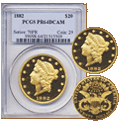 |
Two groups are represented here. The first is Liberty Gold coins. As I mention in a later category there are some very scarce coins in the early period of this type of coin, but Lib’ Gold becomes more available in the latter years of its striking. Blending two earlier categories these coins can be looked at as individual or as sets. We recommend both and we feel that all Denominations of Gold coins are desirable here. That would include gold $1’s, $2 ˝’s, $3’s, $4’s (yes, a $4 Dollar Gold piece), |
|
$5’s, $10’s and $20’s. What is important is to acquire an example of what is roundly considered to be some of the finest and most desirable coins available.
The second group represents the ‘Matte” Proof Gold Coins. These more unusual coins are from the U.S. Mints experimentation with a French process that imparted a ‘granular’ or satiny look to the coins. Very delicate, they marred easily. Consequently they are very Rare today. These coins are in the $2 ˝, $5, $10 and $20 Dollar denominations and all are recommended. For both major groups, barring those tough early dates we feel that Proof 65 and up represent an opportunity. There is a plentiful amount of research and price reporting available on these coins so do not be afraid to look at the charts of this market. Though it will show some peaks and valleys you can see a very consistent growth and strength in this area. |
|
4. Better date $20 Saint-Gaudens Double Eagles, $10 Indians,
$5 Indians
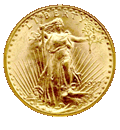 |
A large option, range of price and degree of availability in this group. These are all coins from the 20th Century; beautiful in their design and very recognizable to the numismatic public (remember the popularity criteria). We would restrict this recommendation to the better dates of these series to avoid the mad Gold rush (up and down) and to firmly position you in a higher degree of rarity and consistent growth. This recommendation is for coins |
| of the grade Mint State 65-and up-condition though a wise buyer would temper that a bit relative to the rarity of the date (I would still floor the better dates at MS-64). As a company we have assembled these coins in complete collections and are proud to count some of the Finest Collections Known for these denominations. We would certainly like to add to this achievement with any interested parties willing to assemble a complete line of dates for any or all of these denominations. | |
5. SEATED LIBERTY SILVER DOLLARS, 1840 - 1873
(Mint State & Proof)
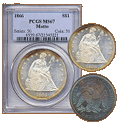 |
Designed by Christian Gobrecht based on his very successful and well received designs of the 'Gobrecht Dollar', .900 fine silver, 38.1 mm diameter, made in Philadelphia, New Orleans, Carson City, and San Francisco. One of our favorites based on Rarity, Demand and Supply. These coins were made both without the motto, "In God We Trust" (from 1840 to 1865) and with motto (1866 to 1873). We have no preference between the two as |
| both types fit well within the criteria for our choice. These coins are large denomination pieces that are very popular with the collecting/investing public and have fairly low populations. By judicious use of grade versus rarity they can be acquired in nearly all price ranges from the low $1000's on up to 6 figures. Both Mint States and Proofs can be found with attractive appearances and though we feel that the market has not focused on this area for some time, these coins are poised to show some seriously impressive growth. We recommend purchasing these coins in the grades '63 and above with some consideration for the rarer dates (where a high grade or even an Uncirculated coin may not be available). | |
6. CONTINENTAL DOLLARS, 1776
(all varieties/ Pewter and Brass)
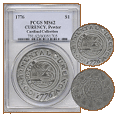 |
I think the Date pretty much explains the reason behind the choice. Aside from the fact that Benjamin Franklin had a hand in the design, it was the new nation’s first proposed coin and the history behind this piece is so deep, I can’t think of any reason not to own this coin. Because of the rarity of the piece we recommend this coin in a wide range of condition from Extra-Fine (XF) up to Mint State 66. It is one of the top 100 coins, number 12 to be exact and |
| all of the aforementioned criteria certainly apply to this coin. There are several varieties of the design and though some are prohibitively rare I would entertain any that fit the budget. | |
7. Cameo and Ultra Cameo (Silver) Seated Liberty and
Barber Coinage in Proof
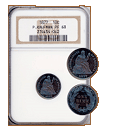 |
This group and the following group are complimentary. Instead of acquiring a complete year set we recommend individual coins. All Proofs are not made equally though. Some are rather bland and brilliant and some have a truly attractive and desirable Cameo frost to them. Toning does not matter here (as long as the toning is attractive, that is), what is important is the distinctive offsetting white flash that the coin exhibits. True examples of the coiners art. There are actually two degrees of |
| deepening Cameo but, depending on the look of the coin, either is recommended. The grade range for these coins is higher because we are looking for the flash here. Attractiveness is the key to this group; do not compromise below Proof 65 Cameo and the sky is the limit. | |
8. PROOF SETS struck between 1834 and 1915
 |
This category is quite broad as well. We are mostly referring to the later dates, as coins prior to 1858 are prohibitively rare (and we do mean Rare). To narrow this down a bit, we are referring to complete Year Sets in either Silver or Gold (watch your budget here!) that are uniform in look. Grades can vary but the overall set should be consistent in its appearance. Those aforementioned early dates are for the advanced collector/investor. |
| Spectacularly rare but very desirable and the market has never been better for these Ultra Rarities. We specialize in the hard to find at Inland Empire so challenge us in this category. Recommended grades are Proof 64 or better in the later dates (1880 - 1915) and "what you can find" in the early ones! | |
9. U.S. SILVER COMMEMORATIVES
 |
There are people on staff at Inland Empire who have done multi-decade price studies and extensive research into these wonderfully collectable and highly interesting coins. We know our stuff! There are 50 different types of Silver Commemoratives, mostly Half-Dollars with one Quarter and one Dollar. The date ranges of the group we recommend go from 1892 to 1946. No modern commem's need apply! There are some very |
| inexpensive coins in this group and a small number of expensive/rare ones. We would diversify the purchases and, in fact, why not try to collect the entire series! It is affordable and very satisfying to build. This can be done as a 50 coin set or a 144 coin set (because of multiple dates and mintmarks). I would restrict my grades to no less than Mint State 65 (though you could fudge a bit on the Rare ones) and some of these coins are quite affordable and available in 67 or 68 grades. A great set and a group of coins that are really off their highs. | |
10. COLONIAL COINS
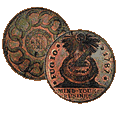 |
Caviar for the true collector. Although this group comprises coins like the pictured Fugio Cent (a Top 100 coin and a highlight of this group) most of these coins from 1652 to 1788 are for real collectors and are very rare in any condition. Not for the average investors due to the nature and rarity of the coins, they have, none the less, proven to be a consistent winner for appreciation. We recommend these coins in Condition Census grades. Because of the |
| scarcity, which may vary to a great degree, try for the finest quality achievable (and don't be surprised if it is a very low grade). | |
SOME HONORABLE MENTIONS
TERRITORIAL GOLD COINAGE
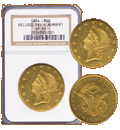 |
This series of coins starts in the 1830's with some very interesting Gold coins from Georgia; the Bechtlers, Templeton Reid's and finishes with some fabulous California Gold just prior to the opening of the San Francisco mint in 1854 and some Colorado and Utah gold in the 1860's. Along the way it comprises some very great firsts. The First Gold $1, the First $20 Gold Coin and some neat $50 Gold pieces called 'slugs'. There are coins minted by the Mormons, Pikes Peak Gold, and a raft of early Gold |
|
mining and smelting companies from California that tried their hand at greasing the wheels of commerce (and making a few bucks along the way). There are stories of light weight coins, monopolies and not just a few shady deals that were thrown in for good measure. California Gold Rush times figure prominently and add tremendous spice with the tails of the Barbary Coast. As more and more books have come out on the subject and as more knowledge has infused the market these coins have proven to be very impressive gainers. The rarity was always unquestioned, now the market is catching up. We will tell you now that it has a long way to go!
This is a strong Honorable mention, for although it holds great interest for the collector or advanced collector, we believe it should now be closely scrutinized by the Numismatic Investor as well. Own your own piece of the Gold Rush today! We might add as a caveat that we are not recommending fractional gold or most of the treasure gold that you may see advertised. Nor are we suggesting that you purchase the Gold Ingot Bars that are out on the market today. The coins described here are all well researched, substantial numismatic items that been in the marketplace (not the bottom of the ocean) for years. |
|
COLLECTIONS OF EARLY COINS
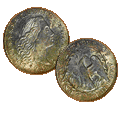 |
Building on the earlier premises of what we believe in, we feel that anyone able to build a set of early coins, or a run of say, Gold from 1795 to 1933 would be one of the select few in the Numismatic market that achieves the unachievable. This kind of set building is what some of the finest collections in the world are made of. It doesn't have to be so comprehensive and there are somewhat lesser degrees of this form of investing but we at Inland Empire |
| pride ourselves at the success we have when challenged this way. The coins referred to here are generally Type sets of periods such as 1794 to 1807 or a broad collection of the major types of Bust Dollars to name a few groups but there are a number of other areas to consider. This category is only for the deep thinkers out there, but don't kid yourself, it can be done and it is rewarding. Explore this area, but be warned, once you start-it will become a passion. | |
And Now for the Top Ten Coins To Avoid
1. Kellogg $50 and Baldwin $10 "Horseman" gold Restrike coins
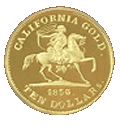 |
The Restrike coins that were prepared from melted-down bars of shipwreck gold are certainly wonderful novelties, carefully packaged and with a great historical tagline, but the fact remains that they are just what their name implies…restrikes. They are not coins minted by any government authorization nor do they have any age to bolster their collectability. Dispelling that, one then needs to examine their value. The fact remains that there is |
| only two ounces of gold in each Kellogg Restrike coin (current retail $2,500) and one-half ounce for the Baldwin $10 horseman (current retail $1,450), do the math. Furthermore, thousands were made of each Restrike just in the past few years, so these coins are not rare, nor scarce. They are merely novelties with intrinsic value. Since their issue, the retail price for the Kellogg Restrike coins have dropped in value by 50% ($5,000 to $2,500), all the while the spot price of gold has increased from $300 to $400. Our suggestion is to wait until your trusted dealer has to buy the coins back out of an estate for melt value, and then add them to your collection if you are so inclined! | |
2. Treasure Bars
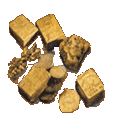 |
In long past years I have actively bought and sold many early Gold Bars from various minters from California and the Southern mines around Charlotte and Dahlonega, both from auction and private treaty. That was when these bars were very rare, scarce and very specialized. That was also when hundreds (!) had not miraculously appeared on the market from the long forgotten depths of the ocean (with more on the way). We have never |
| been favorites of 'flash in the pan' or highly promoted coins and these bars are no different. It did not help that they were priced at the same approximate ratios of Gold vs. weight, etc. that they had been when they were far scarcer. We have missed a few boats (opportunities) in our professional careers but we have always tried not to hitch a ride on ones that would sink! (excuse the pun) In cases of promotions, even promotions of things that are legitimately rare and historical, we always feel that in the interest of prudence and capital preservation it is wise to allow the market to establish a true value rather than let a promoter establish the value. I wouldn't rush to dump my bars but I would carefully monitor the market and take advantage of opportunities to sell. | |
3. Certified Gold or Silver American Eagles Bullion coins,
PR or MS
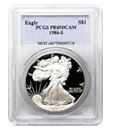 |
What part of the word Bullion did you not understand? There are currently people out there who are grading these modern bullion coins and selling them as if they had actually found something scarce! Do the words, made by the millions yesterday mean anything here? There actually may be opportunities to sell these coins if bullion keeps moving up but I would certainly be shocked if you were able to receive any of the premiums that you paid over spot |
| when you bought them. In this case of hype and promotion I would certainly call the promoters who sold you the coins and see what they intend to do for you on a buyback. Since bullion is moving so well this could have a saving grace but tread carefully here. (This goes for Platinum coins also.) | |
4. Modern Contemporary Commemoratives 1982 to present
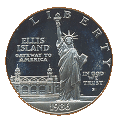 |
Do not confuse this group with the early U.S. Silver Commemoratives that we feature in our Top Ten. Those coins have historical significance and rarity. These coins, though I will admit to a small collection of my own, are mere interesting collectables. Starting in 1982, the U.S. Mint began striking these modern commemorative coins with the Washington 50C piece. They are made with huge mintages and are very popular. The Mint |
| finally discovered what the Post Office found out 50 years ago. They were minting money! As flippant as that sounds, the Mint figured out that they could make millions of coins with a collectable interest and people would fall all over themselves and buy them (at a profit to the mint). This leads to a double edge sword. On one hand, it has favorably increased the visibility and interest in coins a thousand fold, on the other hand, from a buyer's perspective, if you think that these coins are rare or that they will appreciate to a degree to make this profitable you are going to be disappointed. I fervently wish for the mint to continue these interesting and entry level collectables but we want to advise people to buy the Right coin, not just any coin. Remember the first word in Rare Coins is… Furthermore, it is a market which promoters can set their own pricing for the high-grade certified coins, only to pull out of the market when their supply is sold out. | |
5. Certified State Quarters
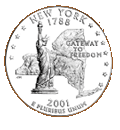 |
This category is a natural spin off from the one directly above it. These coins are probably as responsible as any single reason for the huge upsurge in collecting coins by the public. Again, I wish to congratulate the mint on a successful program and business venture. My children collect these quarters, my friend's children collect these quarters, adults of all stripes collect these quarters, and it is phenomenal how successful this program |
| is. On the dark side however, coin promoters (yes, those amorphous guys) discovered that if you certify these coins there is a deep market. The trouble is, there is also a deep supply. Whether it is proof coinage or mint state the mint is cranking these little gems out in huge numbers and they can be found in perfect condition. Very much like the Modern Commem's this leads to a high likelihood of the coins grading fantastically high. When graders first started grading these and the other modern coins they were pleased with Proof or Mint State 68's and thrilled with Proof or Mint State 69's. Now, nothing less than a perfect 70 will do. That has to raise the warning flags. Promoter heaven, Investor Hell. | |
6. Error coinage
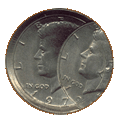 |
A very interesting area. There have been some recent books out on this specialty and now, both major grading services (PCGS and NGC) have begun to certify certain errors, both modern and earlier (prior to the 1940's). The problem here is not so much the history or specific defect (though the variations are sometimes extreme) but any cohesive form of market and value. To enter this category with less than years of experience both with grading |
| and pricing is to enter a minefield. I would not encourage all but the strongest at heart to follow this field. We would also strongly advise people to stay out of the Modern Error field as there have been several scandals involving Mint employees and others promoting coins that shouldn't have been. Set the Hurricane flags out here also. | |
7. High Grade Registry Sets of Modern Singles pre-1950
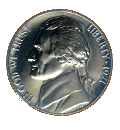 |
Since their inception, Registry sets have bolstered the market for Rare Coins at a most impressive rate. Collectors (and investors) are virtually falling over themselves to compete for the most complete or highest grade set. We, at Inland Empire are responsible for quite a fair number of these complete or high grade sets. But, before you begin to wag your finger at us, I refer you to …the but. The sets to build are of early (1790's and |
| up) or rare (Mint State Seated Dollars) or scarce and popular (Proof Morgan's, etc.). Not the modern, the available, the obscure. I don't wish to upset anyone, and I know that there has been a tremendous upsurge in collecting here, but Roosevelt Dimes just don't do it and Jefferson Nickels are for a Whitman album. I shake my head at some of the phenomenal prices that are realized at auction (and on the bourse floor) for coins of this ilk. Modern coins are still in the Banks. They are still available by the roll. When was the last time anyone saw an original roll of Barber Halves (if anyone raises their hand, call us immediately, we want to buy). We are monitoring a Tulip Bulb mania in the modern Registry Set market. Don't be holding these coins at these numbers when the music stops. | |
8. Walking Liberty half dollars 1941-1947:
the 20 coin "Short Set."
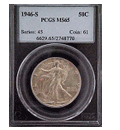 |
The 20-coin "short set" of Walking Liberty half-dollars has always been a favorite issue for many collectors, especially in MS65, MS66 and MS67 condition. After all, the striding Lady Liberty was selected by the U.S. Mint for the obverse of the Silver American Eagle coin. Past price performance has certainly been dramatic over the past 15 years, too. As a result, care must be exercised when purchasing these coins. In 1989, the MS65 set was |
| trading for approximately $20,000; in MS66 $50,000; in MS67 $120,000! Today, these levels are $6,500 (1/3rd); $17,500 (1/3rd) and $75,000 (1/2) respectively. But a February 2004 issue of the Certified Coin Dealer newsletter tells us that the bids for the "short set" in these grades have doubled over the past 3 years! It is our impression that these sets are about to be heavily marketed and sold retail. Once this promotion is over, the levels will settle back again. Exercise caution when buying or sell your set into this market! **Do not confuse these later date Walkers with the very rare and elusive early Walking Liberty Halves (1916 - 1940). There are some very scarce coins in this group that certainly deserve attention. | |
9. Copper coinage
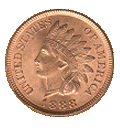 |
Another split group. There are some very rare and desirable coins in this group. I highly recommend coins like 1793 Chain cents or Wreath cents and the like. There are Indian cents in Mint State or Proof that I like as well, so what's the beef? (Anybody remember that line?) Its color and condition. The most reactive or prone-to-deteriorate coin out there is copper (nickel can be a problem to but not to the same degree). I have always tried to |
| caution collector/investors away from buying into problems. The market is tough enough, why add to the complexity and uncertainty. Most Red Copper can, like a bad dog, turn on you and the place it bites is in the pocketbook. Value on many high grade copper coins come from a pristine, natural bright color on the coin. If the holder leaks air, someone sneezed before holdering the coin or an errant fingerprint shows up, look out. Still to this day, after all these years of Coin Certification, I would not buy a Full Red (or even Red Brown) coin of any date without physically seeing it in my hands. | |
10. $2.50 Indians
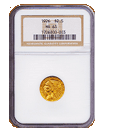 |
I love these coins, the incuse design (on them and the $5's) is interesting, historical and the set is a fun thing to build. But…here it comes; there is a time and a place for everything. In the ebb and flow of the coin market one must be attuned to the opportunity to buy and sell. An advertisement appearing in the June 2001 Coin Dealer Newsletter Monthly Summary, read, "Why did $2˝ Indians Explode?" An accompanying chart reveals that prices for the series are up an average of 50% over |
| the last 18 months. MS63 graded coins are up 65%; MS64 graded coins are up 50%; MS65 graded coins are up 35%. Nearly three years later, we're happy to say the $2˝ Indian quarter eagles are up an additional 98% (MS63: 119%; MS64: 107% MS65: 70%). There is no doubt about it…this is a very collectible series and has performed extremely well as an investment in such a short period of time. For many of the 15 coins that make up the set, however, these prices are at or have surpassed all time highs. As a result, we believe it is time to divest your position of $2˝ Indian quarter eagles in these grades and reallocate your funds. No one ever died from taking a profit, and hey, the coin market works! | |
Editors Note: That's the good news and the bad. Some of the categories are broad but that is done on purpose. The coin market is a fluid industry and we want to be able to impart the most timely and valuable information we can. To do this, the information needs to be fresh and immediate. We encourage you to call your portfolio manager today and find out about the coins available-right now, not warmed over stale inventory.
Thank you and we hope you find our information and musings helpful.
David W. Hunt


|
Numismatic Market Watch
Opportunity. Now there's a word that is so overused that it has been rendered almost meaningless. No matter whether the market is declining, advancing, or locked in neutral, there are those who will always tell you that now is the opportune time to get involved.
Well, I'm going to commit the very sin that I've just complained about, and call this market the best opportunity of the last two decades. There's one difference, though, from the average numismatic prognosticator. I'm going to explain why this is the best opportunity of the last 15 years, and back it up with some carefully researched facts. We are currently in a bull market, even though it has been a mild one in many areas. Since early 1995, a diverse group of US coins totaling 3,000 different dates, denominations, and grades has risen 27.3%. While that growth has outpaced a passbook savings account, it's not exactly front page news. In comparison, let's look at the three previous bull markets: 1970-74-This great market saw an increase of 348% in the value of the same 3,000 dates, denominations, and grades mentioned above. 1976-80-The greatest bull market of all time actually started in December of 1975. By the time it peaked (along with $850 gold and $50 silver) the market was up an amazing 1,195%! 1982-90-Another incredible bull market that fragmented, with many coins continuing upwards through March of 1990. The final tally? Up 665%. With this kind of growth, rare coins might seem to be overpriced by now, or at least fully priced. But there's an explanation why that isn't the case, even though it's not a happy one for many investors. The bear market of 1990-94 saw a precipitous decline of 74%. A quality $10,000 portfolio fell in value to about $2,600. An unprecedented five-year fall in prices left analysts looking at numbers that hadn't been seen in 20 years. The new bull market has seen explosive growth in several areas, most notably in the ultra-rarities. Previous price records have been obliterated for 1804 dollars, 1913 Liberty nickels, and other classics. But what about the $10,000 TO $100,000 collector/investor? Is now the time for him (or her) to make a serious commitment to the market? Yes! And here is why. 1)--The average bull market shows an increase in value of over 700%. At the current 27.3% increase, this bull market is still taking baby steps. 2)--Bull markets have been fueled by different scenarios in the past. It was thought at one time that hyper-inflation or rising gold and silver prices were necessary elements in a bull market. This bull market, in contrast, is actually driven by prosperity. 3)--The flight to the "alternative investment" has begun in earnest. There is more money coming into the rare coin market now than at any other time in the 1990's. 4)--Prices are at bargain levels. Just because something used to be worth $10,000 and is now worth $3,000 doesn't mean it's a bargain. The roll market of the 1960's has never recovered. Common date MS65 dollars won't be $800+ again (in all probability) for decades. But the bargain I'm talking about is Rare coins! There are areas of opportunity with staggering potential. High quality gold type coins, silver type coins, key dates within numerous series, and on and on, 5)--The recovery is complete. Some prices were beaten down to the point of asking: "How can that be?" If you think this is an exaggeration, just compare the prices of silver commemoratives in 1989 to those of today. But silver commemoratives, Walking Liberty half dollars, and type coins (along with everything else) are showing renewed interest, stable and/or rising prices, and superb value. 6)--Henry Ford once said: "All there is to economics is supply and demand." That statement may make a few economists blanch, but there is insightful truth in its simplicity. There is a definite supply crunch taking place in the market. Its cause? Need I say it? Of course, it's demand, created by the five reasons that preceded this one, plus other positive factors. 7)--Risk is low. Any investment involves risk, of course, but ask yourself: "Do I want to get involved in a hot market when things are at a 20-year high or when they're at a 20-year low?" The next question on the agenda is: "Who should I pick to be my dealer in the coming bull market?" You want someone with experience, a great reputation, a proven track record, vast numismatic knowledge, top negotiating skills, and, most importantly, the one who will help to create the best bottom line for you. |
